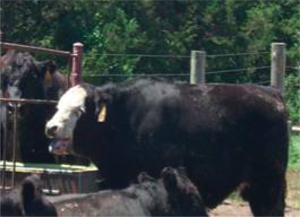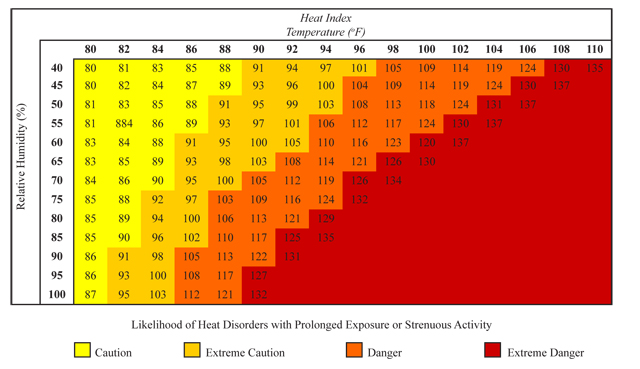G2121
Heat Stress — What You Should Know to Make Livestock Shows a Success
Heat stress is hard on livestock, especially if it is in combination with high humidity and low wind speed. The degree of heat stress is dependent on the animal’s activity, body condition, coat cover and color, and disposition.
Lindsay M. Chichester, Extension Educator
Terry L. Mader, Extension Beef Specialist
- Signs of Heat Stress
- Effects of Heat Stress
- What Is a Heat Index?
- Management Options
- Water Requirements
- Avoid Overworking the Animals
- Confinement
- Animal Weight and Body Condition
- Hide/Pelt Color
- Transportation
- Livestock Show Recommendations
- Summary
- Resources
Signs of Heat Stress
Signs of heat stress (depends on species) may include animals bunching, seeking shade, panting, slobbering or excessive salivation, foam around the mouth, open-mouth breathing, lack of coordination, and trembling. (Figures 1 and 2). If these symptoms are observed, assume the animal has a heat load. Immediately try to minimize the stress to the animal, especially its handling or movement.
Previous health of individual animals is an important risk factor; animals that have had past health problems will be more affected by heat stress than animals with no prior health problems. These animals will generally be the first to exhibit signs of heat stress and be the most severely affected.
 |
 |
|
| Figure 1. Cattle undergoing moderate to severe heat stress exhibit open mouth breathing and excess salivation. | Figure 2. A beef animal undergoing severe heat stress exhibits open mouth breathing with tongue out, head extended. |
Effects of Heat Stress
Hot weather and high humidity can reduce feed intake, weight gain, reproductive efficiency, and milk production, while increasing susceptibility to disease. Changes in behavior and even death can also occur.
The comfort zone for animals varies depending on age. Young animals generally have a narrow comfort zone between 45°F and 80°F; while the range in temperatures of the comfort zone of mature animals can be wider. For example, with feedlot animals and mature cows the comfort zone can range from below zero in the winter to about 75°F in the summer. Bos indicus (humped cattle) do have better heat coping capabilities and can easily tolerate temperatures above 90°F (Table I).
| Table I. NOAA’s National Weather Service. (Source: http://www.nws.noaa.gov/os/heat/index.shtml.) |
 |
What Is a Heat Index?
Environmental stress is dependent on temperature, humidity, wind speed, and solar radiation, which is best determined by an index. The index that is most commonly used is called the Heat Index, commonly reported by many media outlets during the summer. This index, used for humans, has a threshold that is very close to the livestock temperature-humidity index.
The following guidelines should be followed for show animals:
- Heat index above 100: Stressful for the animal, but it will be able to tolerate it if shade is available and/or wind speed
is at least 10 mph. Thus show animals should be provided shade and/or moving air via fans.
- Heat index above 110: Stressful for the animal regardless of wind speed. Show animals should be in the shade with fans,
especially market-ready animals, and have plenty of access to water. If a heat index above 110 is predicted, livestock shows
should be completed by noon. In addition, livestock that need to be moved or transported should be out of the facilities by early
morning but certainly by noon, if possible.
- Heat index above 115: Avoid moving or handling market-ready animals. Livestock show rings should be shaded with fans and
misters; show staff should consider postponing the show due to excessive heat.
- Heat index above 120: No activity should occur for animals or humans. May cause serious health risks or even death.
Keep in mind that using the heat index value does not account for nighttime cooling, which can be a good indicator of overall heat stress. When animals do not cool down at night, they become compromised and are less capable of handling a heat load.
Management Options
Management options include providing shade, ventilation and air flow, clean and cool water, wetting, cool water drench, and sprinklers or hoses.
- Shade can be provided by trees, buildings, or other sunshades. In addition, the temperature can be lowered by spraying
cool water on the roof and walls of buildings where animals are being housed.
- Improved ventilation can be provided by fans or opening windows on a breezy day. Sunshades should be high enough off the
ground (10 feet or more) to allow for adequate air movement.
- Clean and cool drinking water is essential to keeping the animal’s internal body temperature within normal limits.
Providing cool drinking water will help cool the animal’s core. If water space is limited, provide additional portable water
troughs.
- Wetting is a good way to cool an animal suffering from heat stress. The animal should be gradually wetted with cool water;
avoid excessive cold water for this purpose. Gradual wetting may need to be repeated until the heat stress symptoms have
dissipated.
- Cool water drench (administer orally) may help quickly decrease the animal’s core temperature. This very effective method
should be performed by someone who has experience in drenching an animal.
- Sprinklers or hoses can provide some relief to heat-stressed animals. The water droplet size should be large; misting (small droplets) may only add humidity and moisture to the air. Keep in mind if animals are not acclimated to sprinklers they may become frightened, which will add to their stress level.
Water Requirements
At 90°F, water consumption can be almost twice that at 70°F. For example, on days where the temperature exceeds 80°F, cattle may need more than two gallons of water per 100 pounds of body weight. Also, water requirements vary from species, to species and on metabolic and physiological needs. For instance, water needs will vary depending on the weight of the animal, lactation, and moisture of the feeds being consumed. Water prevents dehydration and allows heat to dissipate through sweating and urination.
The amount of water an animal drinks will be largely dependent on the amount of water lost through evaporation from its skin or lungs, as well as through urination. If the environmental temperature and/or physical activity increase, then it is safe to assume that water losses through evaporation and sweating will also increase.
Avoid Overworking the Animals
Body temperatures of livestock exposed to high daytime temperatures tend to peak in the early evening, decline during the night, reach a low point in the hours just before sunrise, and rise again slowly throughout the day. It is recommended to work/process livestock in the morning. Avoid working them in the late afternoon/early evening when their body temperature is already high. Processing cattle can elevate their body temperatures ½ to 3½ degrees.
Confinement
Animals in confinement will usually have higher heat loads than animals grazing pasture. This is due to possibly less air movement and less shade availability in a confined area. Also, there is more exposure to radiant heat associated with concrete or dark, bare soils.
Animal Weight and Body Condition
Livestock heavier in weight or having a higher body condition score are generally more susceptible to higher heat loads than livestock lighter in weight, or with a smaller body condition score.
Hide/Pelt Color
Usually, animals that are dark hided or dark pelted are more susceptible to heat stress than their light hided/pelted counterparts. It is best to assume that all animals are susceptible to heat stress, regardless of hide/pelt color.
Transportation
If possible, avoid transporting livestock during heat stress periods. If transportation cannot be delayed, it should be done in the evening or early morning when temperatures are cooler. The transportation of heat-stressed livestock to a harvest facility may have a negative effect on carcass quality, such as dark cutters in cattle, or PSE (Pale, Soft, and Exudative) in pork.
Livestock Show Recommendations
If the weather report in the morning indicates a heat index of 115°F or above, consider postponing a livestock show to early the next morning. This is a rule that may need to be added to fair books and discussed with 4-H councils and/or fair boards. It is important to keep in mind that animal and exhibitor health should be the primary deciding factor.
Summary
It is important to take precautions during the summer months to ensure that animals suffer as little as possible from heat stress. Provide livestock with shade if possible, and plenty of clean, cool water. Try to limit other activities that may increase their stress, including movement and/or hauling. If an animal shows severe heat stress symptoms, contact a veterinarian immediately.
Resources
Boyles, S. (n.d.). Heat stress and beef cattle. Ohio State University Extension. Found online Oct. 12, 2011 from http://beef.osu.edu/library/heat.html.
Collier, R. J. and Zimbelman, R. B. (2007). Heat stress effects on cattle: What we know and what we don’t know. Department of Animal Sciences, The University of Arizona. Found online Oct. 12, 2011 from http://ag.arizona.edu/ans/swnmc/Proceedings/2007/Collier_2007SWNMC.pdf.
Epperson, B. (2006). Handling heat stress in cattle. South Dakota State University Cooperative Extension Service. Found online Oct. 12, 2011 from http://www.sdstate.edu/abe/wri/water-quality/upload/ExEx11011.pdf.
Mader, T. (2011). Heat stress on show animals. University of Nebraska–Lincoln. Personal communication on Oct. 02, 2011.
Mader, T., Griffin, D., and Hahn, L. H. (2007). Managing feedlot heat stress. NebGuide G1409. Found online November 4, 2011 from http://www.ianrpubs.unl.edu/sendIt/g1409.pdf.
Rasby, R. J. and Walz, T. M. (2011). Water requirements for beef cattle. University of Nebraska–Lincoln. Found online Oct. 12, 2011 from http://www.ianrpubs.unl.edu/sendIt/g2060.pdf.
This publication has been peer reviewed.
Visit the University of Nebraska–Lincoln Extension Publications website for more publications.
Index: Beef
Miscellaneous
Issued February 2012